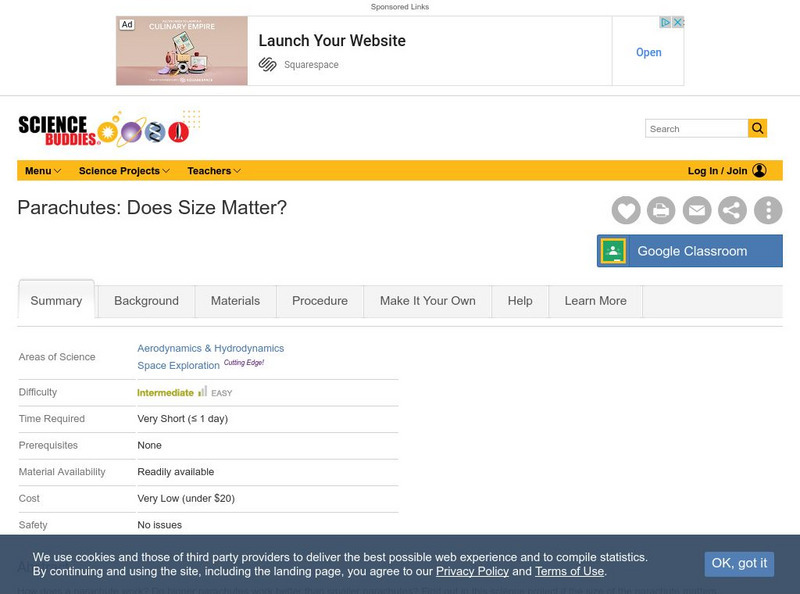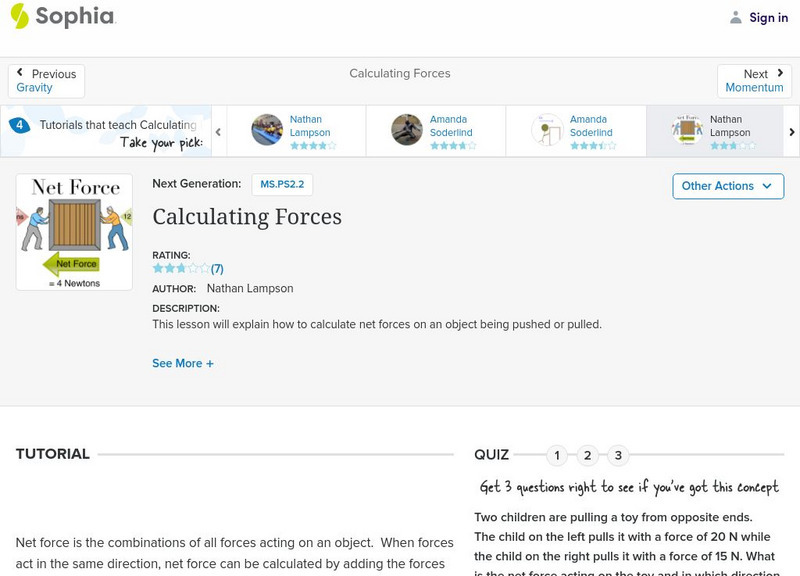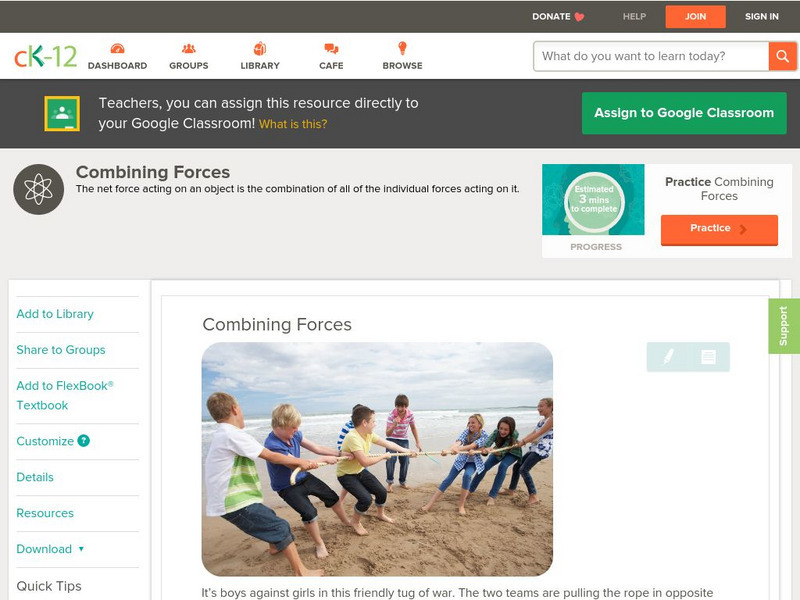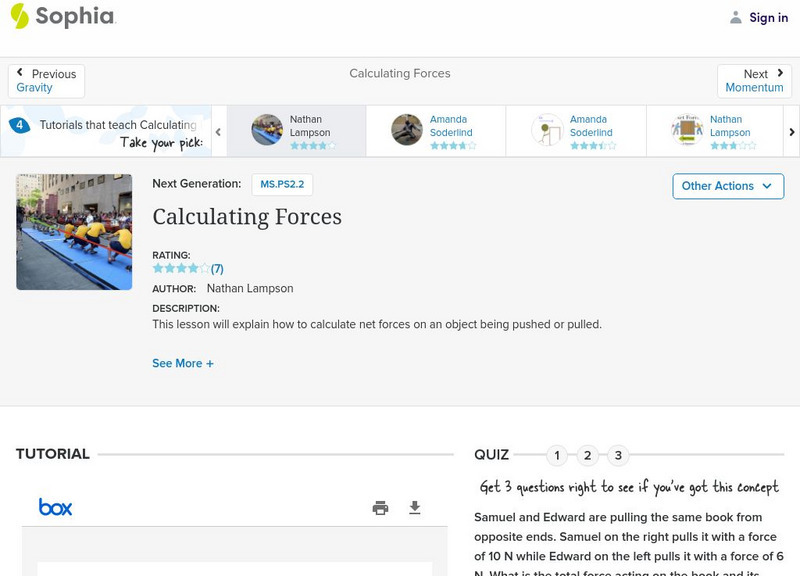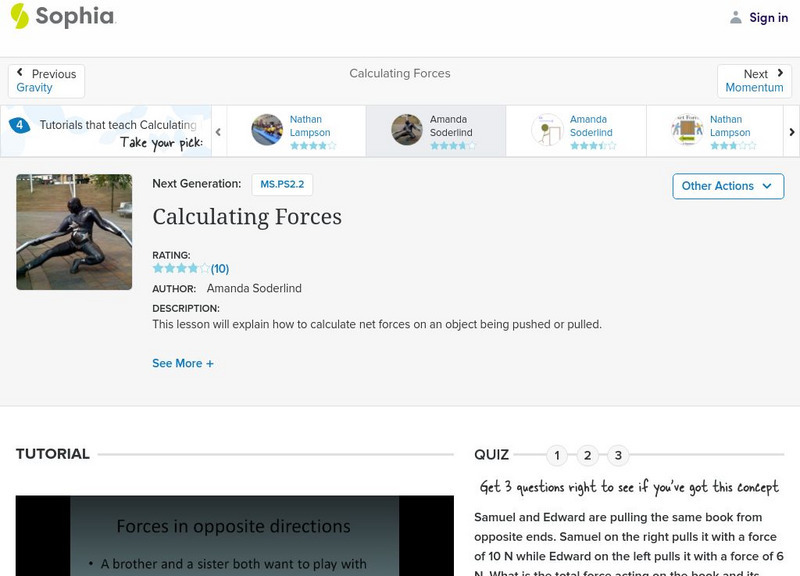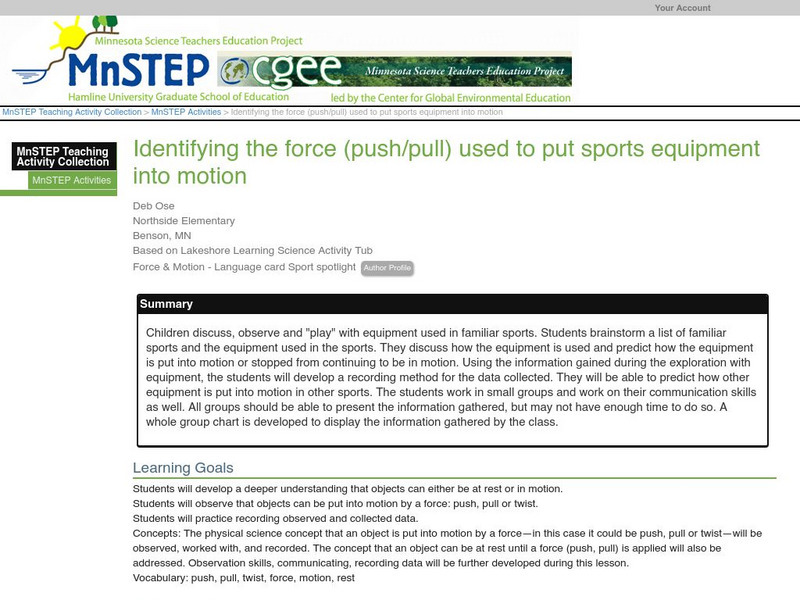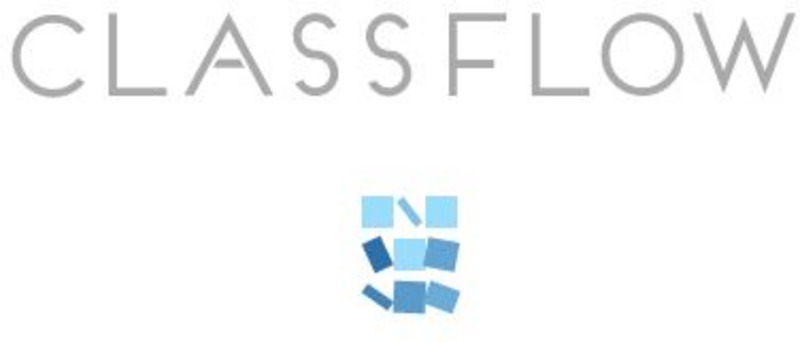Science Buddies
Science Buddies: Parachutes: Does Size Matter?
Experiment with different sizes of parachutes to find out if size matters when slowing the descent of the parachute. The Science Buddies project ideas are set up consistently beginning with an abstract, objective, and introduction,...
Sophia Learning
Sophia: Calculating Forces: Lesson 2
This lesson will explain how to calculate net forces on an object being pushed or pulled. It is 2 of 4 in the series titled "Calculating Forces."
Sophia Learning
Sophia: Calculating Forces: Lesson 3
This lesson will explain how to calculate net forces on an object being pushed or pulled. It is 3 of 4 in the series titled "Calculating Forces."
University of Colorado
University of Colorado: Ph Et Interactive Simulations: Forces and Motion: Basics
Explore the forces at work when pulling against a cart, and pushing a refrigerator, crate, or person. Create an applied force and see how it makes objects move. Change friction and see how it affects the motion of objects.
Better Lesson
Better Lesson: Stop It! Exploring Forces on Moving Objects
Students will be able to explain what is needed to stop an object by completing a simple investigation. Students will experiment with Hot Wheel cars and record their predictions on a recording sheet. Included are videos of the lesson in...
Utah Education Network
Uen: Catapult Creations
Third graders learn how a catapult works and build their own.
Utah Education Network
Uen: Tissue Parachutes
Third graders create their own parachutes to understand the concept of gravity and the effect it has on objects.
Concord Consortium
Concord Consortium: Spring and Mass Model
An interactive tool where students can explore how a spring behaves, and how changing the elasticity, mass, push/pull force, and friction affect its motion or period. As the spring moves, its motion is shown on a distance-time graph.
Science Education Resource Center at Carleton College
Serc: How and Where Things Move
Students will understand that objects move in many ways, and it takes a forces (pushing or pulling) to move them.
Other
Bscs: Forces Lesson 1: What Makes Something Start to Move?
Through hands-on activities, this lesson will show students that a force is a push or a pull and forces cause changes in motion. Included are a minute-by-minute lesson plan, activities, and teacher discussion points and questions.
Other
Bscs: Forces and Motion Content Background Document
In this document, we will try to answer a fundamental question of physical science, "Why do things start to move, slow down, speed up, stop moving or change direction?" In answering these core questions we can develop concepts that can...
Better Lesson
Better Lesson: A Change of Direction
Students will make predictions and conduct an experiment using marbles to figure out what types of things can cause a moving object to change direction. Included is a video of the lesson in action, pictures, discussion questions, and a...
CK-12 Foundation
Ck 12: Physical Science: Combining Forces
[Free Registration/Login may be required to access all resource tools.] Featurea the definition of combining forces: Pulling down and pushing up, forces acting in opposite directions, forces acting in the same direction.
Sophia Learning
Sophia: Calculating Forces: Lesson 4
This lesson will explain how to calculate net forces on an object being pushed or pulled. It is 4 of 4 in the series titled "Calculating Forces."
Sophia Learning
Sophia: Calculating Forces: Lesson 1
This lesson will explain how to calculate net forces on an object being pushed or pulled. It is 1 of 4 in the series titled "Calculating Forces."
Science Education Resource Center at Carleton College
Serc: Identifying the Force Used to Put Sports Equipment Into Motion
Children discuss, observe, and play with equipment used in familiar sports, and then brainstorm a list of familiar sports and the equipment used in the sports. They discuss how the equipment is used, and predict how it is put into motion...
Other
Math Help: Trying to Pull a Boulder Up a Hill
A practical application of the use of the components of vectors with force. Example and general form are both given.
Concord Consortium
Concord Consortium: Stem Resources: Building a Bungee Jump
Students are asked to create a bungee jump that will protect a hard-boiled egg from breaking. A force sensor is needed to measure the push/pull forces on the egg. Data is inserted into force-time graphs. After completing three...
The Wonder of Science
The Wonder of Science: K Ps2 2: Motion Design Solution
The NSTA vetted source includes resources to teach how to analyze data to determine if a design solution works as intended to change the speed or direction of an object with a push or a pull. Included are assessment ideas, videos,...
Science Education Resource Center at Carleton College
Serc: Investigating Motion With Marbles
For this guided inquiry activity, students will use 2 marbles of different size and a box to investigate what makes the marbles move and what will cause the marbles to change speed and direction.
ClassFlow
Class Flow: Motion
[Free Registration/Login Required] This flipchart describes what motion is and what causes an object to move. Streamline videos, activities, and assessment are included.
Other
University of Tennessee: Football Physics
Classical physics describes and predicts how things work in our everyday environment. Football falls well into the limits of classical physics. In football we encounter many situations where only a few interactions, maybe only one push...
Other
60 Second Science: Rolling Down Ramps Experiment
Explore the characteristics of inclined planes while observing how drops of colored water flow down a ramp and on different surfaces.
McREL International
Mc Rel: Whelmer #9 Learning Activity: Nickel Karate
An easy to do activity that investigates the basic theories of inertia. The activity is in lesson plan format that meets NSES standards.
